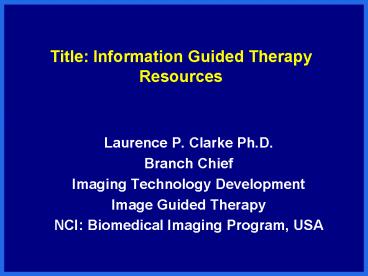Title: Information Guided Therapy Resources - PowerPoint PPT Presentation
1 / 18
Title:
Title: Information Guided Therapy Resources
Description:
NCI/NIBIB: New funding mechanisms tailored for Imaging Technology Development, ... high risk/high gain imaging technologies, such as molecular imaging, including ... – PowerPoint PPT presentation
Number of Views:34
Avg rating:3.0/5.0
Title: Title: Information Guided Therapy Resources
1
Title Information Guided Therapy Resources
- Laurence P. Clarke Ph.D.
- Branch Chief
- Imaging Technology Development
- Image Guided Therapy
- NCI Biomedical Imaging Program, USA
2
NCI
Division of Cancer Treatment and Diagnosis (DCTD)
Cancer Diagnosis Program (CDP)
Develop- mental Therapeutics Program (DTP)
Cancer Therapy Evaluation Program (CTEP)
Radiation Research Program (RRP)
Biomedical Imaging Program(BIP)
Diagnostic Imaging Branch
Molecular Imaging Branch
Image-guided Therapy Branch
Imaging Technology Development Branch
3
Branches ITDB and IGT
- Support basic research, technology development,
integration, and feasibility testing for novel
imaging sensors and contrast materials. - Develop initiatives to facilitate partnerships
with academia/ industry/ SBIR/STTR. - Develop of centers of excellence, imaging
networks and research resources to promote
translational research. - Promote programs(NIH inter-institute and
inter-agency programs within the USA) and
international.
4
NCITypes of New Initiatives (1998-01)
- Research Centers of Excellence (Molecular
Imaging) - Small Animal Resource Centers (Molecular Imaging)
- National Distributed Research Resources
- Research Interface Software ( Ultrasound).
- Image Databases for Software Evaluation
(Lung CT). - Platform Independent Imaging Methods (MRI).
- NCI/NIBIB New funding mechanisms tailored for
Imaging Technology Development, including
IGT/IGS.
5
(No Transcript)
6
NCI/NIBIB Novel Imaging Technologies
- Aim Support high risk/high gain imaging
technologies, such as molecular imaging,
including proof of feasibility studies as opposed
to hypothesis based research. - Goal Full support for the development and/or
integration of novel technologies with
traditional imaging methods with specific
deliverables at the end of the funding period. - Areas
- Early cancer detection/ other disease processes.
- Large screening applications/ other disease.
- Imaging for diagnosis, staging, therapy.
- Image guided biopsy and novel forms of therapy.
7
PAR Novel Imaging Technologies
- NCI/NCRR Phased Innovation Award (R21/R33).
Specifically designed for technology development,
with provision of academic/ industry
partnerships. - Combined R21/R33 or R33 alone R21 Feasibility
study. R33 Technology development / feasibility. - Parallel SBIR/STTR Similar scope and
timetable. - NCI Review Reviewers Academia and Industry and
small business. - Applications 1st Round 40 4 funded, 2nd Round
70 - Future Multiple Prototypes SB Joint Ventures.
8
Cars 2000 Panel ReportChallenges and
Opportunities in Computer Assisted Interventions.
- Laurence P. Clarke
- Richard D. Bucholtz
- Henry Fuchs
- Ron Kikinis
- Richard A. Robb
- Ramin Shahidi
- Michael Vannier
9
Visualization Standards
- In order to make 3D imaging more reliable and
- widely used, the following protocols are
- recommended to be developed
- Standards for 3D image Acquisition.
- Standards in visualization parameters to
categorize various types of tissues in 3D models. - Standards for interpretation of 3D images.
10
Validation Standards
- In order to make the validation process more
- compatible across platforms, recommend protocols
- Breaking down overall systems errorin a given
system to its basic components. - Protocols wherein all basic errors components can
be tested and measured using the same criteria. - Initiating open dialogue between centers for
communication and sharing validation results.
11
Automatic Segmentation
- Need for involvement of non traditional
- disciplines and approaches
- Attract new investigators ( Computer scientists,
mathematicians and pattern recognition experts). - Identify and distribute international
requirements for image segmentation verses
diagnostic requirements for the scientific
community. - Specific segmentation research for IGT, such as
interactive methods as necessary to enhance
reliability.
12
Real Time Visualization
- Need for implementation techniques for real
- time image rendering
- Real time volumetric data deformation techniques.
- Fast 3-D visualization of inter-operatively-acquir
ed data, such as US images. - Mechanisms for intuitive presentations of 3D
information during ongoing surgical procedures,
such as augmented reality
13
Data Correlation
- Need to address one of the large sources of
error, - namely tissue deformity that occurs between per-
- operative and tissue intervention using methods
- such as
- 2D/3D registration (e.g. intra-operative X-ray or
endoscopic data registration with CT/MRI). - Identifying and development of quantifiable
methods for the prediction and interpolation of
tissue deformation during therapeutic procedures. - Development of novel algorithms for more robust
registration methods.
14
Tracking techniques
- Significant improvement is necessary for tracking
- of surgical tools in a stereotactic space, and
thus - the following is recommended
- Design of novel instruments for tracking with
emphasis on miniaturized systems using NANO/MEMS
fabrication technology. - Investigation of the effects of tissue types on
such systems. - Computer controlled effectors and interface
standards, in a flexible plug and play format
15
Machine and Human Interface
- There is a need to focus on the human operation
of computer - assisted systems and develop more advanced
systems - Smart tools that can conduct intra-operative
anatomical/ functional imaging and access
trajectory of the surgical path. - Smart displays that minimize the surgeons need to
coordinate eye hand movements and enhance target
recognition. - Customized human/computer interfaces for sterile
environments ( I.e. eliminate keyboards/mouse) - Robotically activated devices for scaling
macroscopic and microscopic movements.
16
New Clinical Applications for Emerging
Technologies
- Systems need to be evaluated based on cost
- increase verses potential health benefit and thus
the - following is recommended
- Set the gold standard for assessing the impact of
specific technologies on medicine. - Measure the benefits and drawbacks for different
IGT technologies. - Create a training programs for IGT technologies
for next generation of physicians.
17
NCI BIP WebPage
- URL www.nci.nih.gov/dip/
- Email Newsletter Monthly Updates js95x_at_nih.gov
- Contact lclarke_at_mail.nih.gov
18
(No Transcript)






























